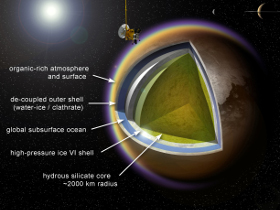Science highlights from Huygens:
#9. Schumann-like resonances: hints of a subsurface ocean
Scientists had wondered whether lightning might be generated in Titan's atmosphere, so Huygens was equipped with the Permittivity, Wave and Altimetry (PWA) experiment to detect tell-tale radio signals.
On Earth, thousands of lightning flashes take place every second, and each bolt generates a radio 'crackle'. This means our atmosphere is continuously generating extremely low frequency (ELF) radio signals, known as Schumann resonances.
These global electromagnetic resonances, excited by lightning discharges, occur in the 'cavity' formed between Earth's surface and the ionosphere – a region of electrically charged particles in Earth's upper atmosphere.
Such a resonance is known only on Earth for being released by storm lightning and it had long been considered that its existence on other planets would make it possible to reveal the presence of both storm activity and a conductive ground.
Although no lightning or thunderstorms were detected in Titan's atmosphere, the PWA did detect an unusual ELF signal at a frequency of around 36 Hertz. Huygens also discovered a lower ionospheric layer between 140 km and 40 km, with electrical conductivity peaking near 60 km.
 |
| This artist's impression of a possible model for Titan's interior includes a global subsurface ocean. Credit: A. D. Fortes/UCL/STFC |
In order to explain the unique pattern of signals, scientists have proposed that Titan's atmosphere behaves like a giant electrical circuit. The electrical currents are generated in the ionosphere when it interacts with Saturn's magnetosphere. This results in a dynamo effect as plasma trapped in the magnetosphere co-rotates with the planet every 10 hours or so.
The lower boundary of Titan's 'cavity', which reflects the radio signals, is thought to be a conductive ocean of water and ammonia which is buried at a depth of 55-80 km below a non-conducting, icy crust.
Huygens' discovery of this unique Schumann resonance is seen as key supporting evidence for the existence of such a subsurface ocean, hidden far beneath the moon's frozen surface.




